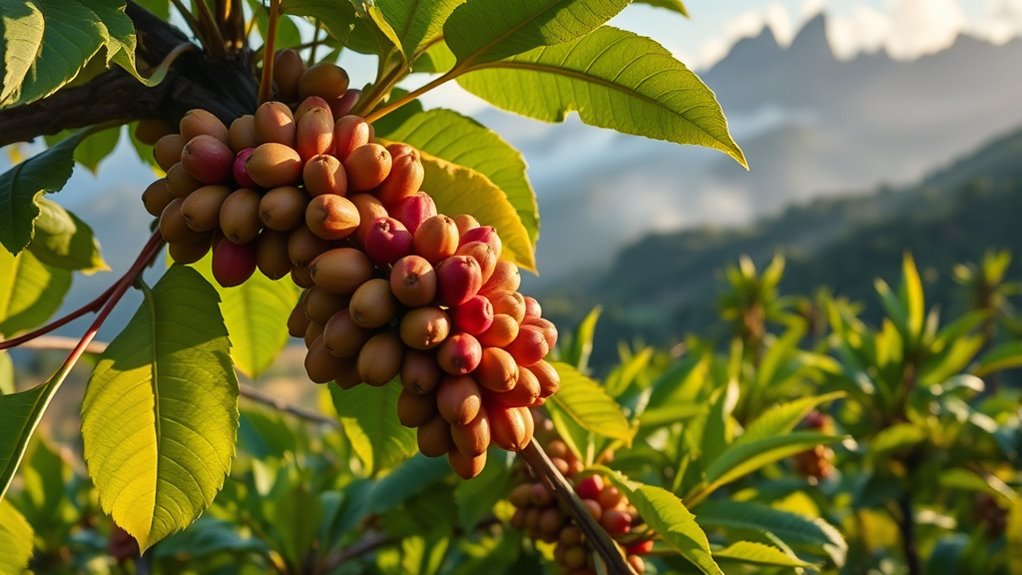Altitude affects coffee acidity by influencing bean density, which directly impacts flavor and sharpness. At higher elevations, cooler temperatures slow bean growth, resulting in denser beans with tighter grains. These dense beans develop more acids, producing brighter and more complex flavors. Lower elevations yield less dense beans with softer acidity. If you want to explore how altitude shapes these chemical changes and taste profiles further, there’s plenty more to uncover.
Key Takeaways
- Higher altitudes produce denser beans due to slower growth and nutrient-rich soils.
- Denser beans develop higher acidity because of extended maturation and acid accumulation.
- Cooler temperatures at high elevations slow fermentation, enhancing chemical processes that increase acidity.
- Increased bean density improves nutrient absorption, promoting acids’ synthesis during growth.
- Variations in soil mineralogy at altitude influence chemical composition, affecting bean acidity levels.
How Elevation Influences Coffee Growing Conditions

Elevation plays a crucial role in shaping the conditions for coffee cultivation. As you move higher, climate variations become more pronounced, with cooler temperatures and increased temperature fluctuations. These changes slow the coffee cherries’ ripening process, meaning harvest timing shifts accordingly. Higher elevations often lead to longer maturation periods, which can enhance bean complexity and acidity. Conversely, lower elevations tend to produce faster ripening, resulting in different flavor profiles. By understanding how elevation influences climate and harvest timing, you can better predict the quality and characteristics of the beans. Recognizing how climate variations impact ripening and flavor development helps in selecting the optimal elevation for specific coffee varieties, ensuring you maximize flavor potential while aligning with local climate patterns.
The Relationship Between Altitude and Bean Density

As you move to higher altitudes, coffee beans tend to develop greater density, which directly impacts their flavor and brewing qualities. This increased density is influenced by soil composition; nutrient-rich, well-drained soils at higher elevations promote slower growth and denser beans. Additionally, harvest timing plays a vital role. At higher altitudes, beans mature more slowly, allowing more time for the beans to develop compact cell structures. This slower maturation process results in beans with tighter, more compact grains, enhancing their overall quality. The combination of the soil’s characteristics and precise harvest timing guarantees that beans grown at higher elevations are denser, leading to richer flavors and better extraction during brewing. Altitude, soil, and timing work together to shape bean density profoundly. Understanding the importance of tight cell structures helps in appreciating how environmental factors influence bean quality.
Chemical Changes in High-Altitude Coffee Beans

High-altitude conditions trigger significant chemical changes in coffee beans that influence their flavor profile and aroma. The soil mineralogy at higher elevations contributes to these changes by providing unique nutrients that alter bean composition during growth. These mineral differences affect the development of key compounds, enhancing complex flavors. Additionally, the cooler temperatures slow down coffee fermentation processes, allowing enzymes to work longer and produce more nuanced aromatic compounds. This extended fermentation results in beans with heightened acidity and brighter flavors. The combination of soil mineralogy and fermentation timing causes chemical transformations that deepen aroma and complexity. Furthermore, remote hackathons can serve as innovative platforms for coffee researchers and industry professionals to collaborate across borders, fostering new insights into high-altitude coffee chemistry. By understanding these chemical shifts, you can better appreciate how altitude shapes the unique taste characteristics of high-altitude coffees.
The Impact of Bean Density on Acidity Levels

Bean density plays a significant role in shaping the acidity levels of coffee. When beans are denser, they tend to develop higher acidity because they grow more slowly, allowing acids to form and accumulate during maturation. Conversely, less dense beans often result in lower acidity because they mature faster, limiting acid development. You’ll notice that high-density beans typically produce a brighter, more vibrant flavor profile with sharper acidity. On the other hand, lower-density beans may yield a smoother, milder cup with softer acidity. This variation occurs because bean density influences how the beans absorb nutrients and how acids are synthesized during growth. Additionally, the brewing method can further accentuate or mellow these acidity differences, allowing for tailored flavor experiences. Understanding this connection helps you select coffees that match your preferred acidity profile, especially when considering altitude’s impact on bean development.
Tasting the Difference: Flavor Profiles of High-Altitude Coffees

Tasting high-altitude coffees reveals a distinctive range of flavor profiles that set them apart from lower-altitude varieties. You’ll notice a heightened flavor complexity, with nuanced notes that evolve as you sip. These beans often boast bright, vibrant acidity paired with intricate aroma profiles, such as floral, fruity, or citrus hints. The cooler temperatures at high elevation slow the bean’s development, allowing richer, more layered flavors to develop. Additionally, the color accuracy of high-altitude coffees plays a significant role in showcasing their vibrant hues and subtle visual details, enhancing the overall sensory experience. As you explore different high-altitude coffees, you’ll find each offers a unique sensory experience, showcasing the altitude’s influence on taste. This depth and clarity make high-altitude beans a favorite for connoisseurs seeking a more refined and dynamic coffee profile.
Frequently Asked Questions
How Does Altitude Affect the Caffeine Content in Coffee Beans?
Altitude’s effect on caffeine levels in coffee beans is subtle but notable. Higher altitudes tend to produce beans with slightly higher caffeine content because the cooler temperatures slow bean maturation, allowing caffeine to accumulate more. You might notice that coffee from high-altitude regions has a more robust kick. So, when you choose beans from different altitudes, you’re fundamentally selecting for varying caffeine levels that can influence your coffee experience.
Do Different Coffee Varieties Respond Uniquely to Elevation Changes?
You’ll find that different coffee varieties respond uniquely to elevation changes due to their varietal characteristics. Some beans develop richer flavor profiles at higher altitudes, while others may become more acidic or balanced. When growing at various elevations, you can notice these differences, as elevation influences bean density and flavor development. This means your preferred coffee’s response to altitude depends on its specific varietal traits, shaping its overall taste and aroma.
What Role Does Soil Composition Play Alongside Altitude in Acidity?
Think of soil composition as the secret sauce that can make or break bean acidity. You’ll find that soil nutrients and mineral content, along with altitude, work hand in hand to influence acidity levels. Rich, well-balanced soil enhances bean development, but poor or overly mineral-heavy soil can flatten or skew acidity. So, it’s a balancing act where soil’s role is essential in shaping the final flavor profile you enjoy.
Can Altitude Influence the Coffee Bean’s Resistance to Pests and Diseases?
You might wonder if altitude affects a coffee bean’s pest resistance and disease susceptibility. Higher elevations often produce beans with thicker skins and stronger structures, boosting pest resistance. Cooler temperatures can also slow disease development, making plants less vulnerable. So, yes, altitude can enhance a plant’s natural defenses, reducing susceptibility to pests and diseases, and leading to healthier, more resilient coffee beans.
How Does Altitude Impact the Sustainability of Coffee Farming Practices?
You’ll find that altitude considerably impacts the sustainability of coffee farming practices. Higher elevations present elevation challenges like shorter growing seasons and cooler temperatures, which can limit yields. To guarantee sustainability, you adapt by employing sustainable farming methods, such as shade-grown techniques and soil conservation. These practices help manage elevation challenges, protect the environment, and maintain the long-term viability of coffee farms at various altitudes.
Conclusion
Imagine tasting a cup of coffee grown at high altitude, where the beans develop a brighter, more vibrant acidity. By understanding how altitude influences bean density and chemical changes, you can appreciate why these coffees stand out. For instance, a small farm in Colombia’s mountains produces beans with unique acidity and flavor. Next time you sip, remember that those elevated conditions are shaping every bright note and tang in your cup.









